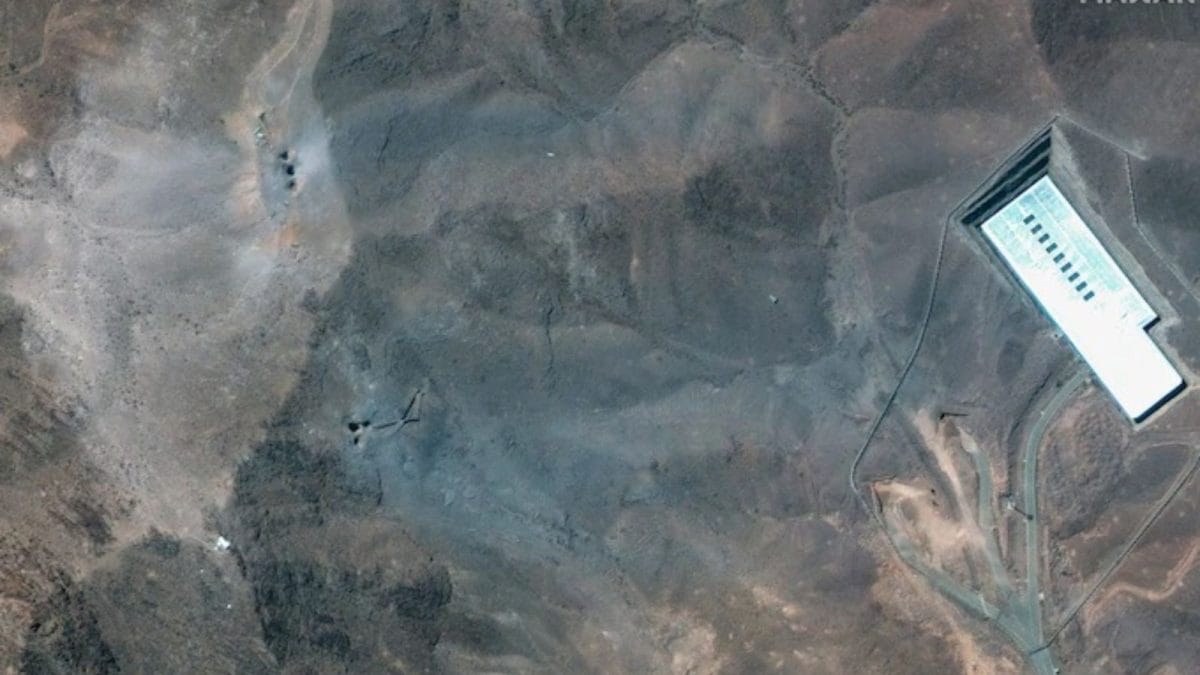ARTICLE AD BOX
Last Updated:July 03, 2025, 15:25 IST
Built by a dozen nations, armed with cutting-edge tech, and flying in three avatars, the F-35 is the world’s most networked combat aircraft

British F-35 jet grounded in Kerala (PTI Image)
On June 14, 2025, a Royal Navy F-35B Lightning II fighter jet made an emergency landing at Kerala’s Thiruvananthapuram International Airport after encountering adverse weather and a low-fuel situation. The diversion, coordinated with Indian Air Force officials, marked a rare appearance of one of the world’s most advanced and expensive fighter jets in Indian airspace. The F-35B variant alone carries a price tag of around $109 million, not including long-term operating costs.
Post-landing inspections revealed a hydraulic fault, which rendered the jet unfit for further flight. Top government sources told CNN-News18 that the F-35B cannot be repaired at its current location, and the United Kingdom plans to deploy a larger transport aircraft to airlift the stranded jet out of India. The British government has also assured Indian authorities that it will pay all associated dues, including parking and hangar charges, for the duration of the aircraft’s unplanned stay.
To understand why this jet’s unscheduled stop in Kerala has drawn global attention, it’s important to look at how the F-35 is built and the international machinery behind its creation.
The Global Machine Behind The F-35
The F-35 is built under the Joint Strike Fighter programme led by Lockheed Martin in the United States. But it’s far from an American-only effort. The jet is assembled through a global supply chain: the UK’s BAE Systems builds the rear fuselage, Northrop Grumman develops key sensors, and the engine comes from Pratt & Whitney in the US. For the vertical-landing variant, Rolls-Royce supplies the lift fan system.
Partner countries involved in production include Italy, the Netherlands, Norway, Canada, Australia and Denmark, each contributing specific components, sub-assemblies or systems. Italy hosts one of two Final Assembly and Check-Out (FACO) facilities outside the US, located in Cameri. The Netherlands serves as a logistics hub for the European fleet. This international industrial structure is designed to promote shared ownership and deepen strategic ties among allies.
Three Versions, One Stealth Fighter
Though the F-35 looks sleek and identical from the outside, it actually comes in three distinct versions, each built for a different kind of battlefield. The F-35A is the most common type, used by the US Air Force and several allies. It takes off and lands like a conventional jet from standard runways and is priced at around $82.5 million per jet.
The F-35B, the variant currently grounded in Kerala, is designed for short take-offs and vertical landings. This flexibility allows it to operate from smaller carriers and forward bases, making it ideal for forces like the UK’s Royal Navy, the US Marine Corps, and the Italian Navy. It is also the costliest of the three, at roughly $109 million per aircraft.
Then there’s the F-35C, designed specifically for US Navy aircraft carriers. With a larger wingspan, beefed-up landing gear and a tailhook, it’s built to withstand the punishing launches and landings at sea. Its unit cost stands at approximately $102 million.
Despite their differences, all three share the same stealthy frame and cutting-edge tech, making it easier for allied forces to train together, operate jointly and maintain the jets on a common support system.
Why The F-35 Is Such A Big Deal
What makes the F-35 truly special isn’t just how it looks; it’s what it can do. This jet was built to sneak through the world’s toughest air defences without being seen. Its stealth design helps it fly under the radar—literally.
But it’s not just about staying hidden. The F-35 is packed with sensors that constantly scan the skies and ground in every direction. All that information gets stitched together and shown to the pilot in one clear display, helping them make split-second decisions with far better clarity than older jets ever allowed.
And the F-35 doesn’t work alone. Think of it like a flying command centre. It talks to other jets, ships, and even troops on the ground, sharing what it sees and helping others make smarter moves too. That’s why it’s often called the “quarterback in the sky."
It can carry weapons inside its body to stay stealthy, or load up on external missiles when staying hidden isn’t the priority. It’s built for everything—from dogfights in the air to taking out enemy radar, gathering intelligence or jamming signals.
Some versions even have nuclear capability, while countries like Israel have added their own tech to customise the jet to their needs.
Partners And Buyers
The F-35 programme officially began with nine development partners: the United States, United Kingdom, Italy, the Netherlands, Canada, Denmark, Norway, Australia, and Turkey, each contributing to development funding and production.
Turkey was later removed in 2019 due to its procurement of the Russian S-400 air defence system. Since then, a series of new operators, such as Japan, South Korea, Finland, Germany, Switzerland, Belgium, Poland, Singapore, and others, have joined via Foreign Military Sales, expanding the F-35 network beyond its original partnership.
Each country that operates the F-35 also contributes to its sustainment ecosystem. Australia hosts a regional maintenance, repair, overhaul and upgrade (MRO&U) facility. Italy’s FACO site assembles jets for European customers. Israel maintains unique integration capabilities with its F-35I fleet.
Why Keeping The F-35 Flying Isn’t Easy
For all its cutting-edge power, the F-35 comes with one major drawback—it’s incredibly expensive and surprisingly hard to keep ready for action.
In recent years, US government watchdogs have pointed out that only about half of the global F-35 fleet is ready to fly at any given time. That’s well below the military’s own goals. The reasons? Long waits for spare parts, software hiccups, and maintenance centres that are overwhelmed and under-resourced.
And the price tag? It’s staggering. The projected lifetime cost of owning and operating the global F-35 fleet stands at over 1.7 trillion US dollars, making it the most expensive weapons programme ever developed. Yes, it’s powerful and packed with futuristic tech, but keeping that tech running smoothly takes a global support network, deep pockets, and constant upgrades.
The Road Ahead: Upgrades And Competition
To stay ahead of new threats, the F-35 isn’t standing still. A major upgrade plan, known as Block 4, is already in motion. This next phase will improve everything from the jet’s radar and electronic warfare tools to its ability to carry a wider range of weapons. It also includes faster processors and better software to help pilots deal with increasingly complex battle scenarios. In short, Block 4 is designed to keep the F-35 sharp, adaptable, and combat-ready well into the next decade.
Meanwhile, other countries are developing next-generation fighter jets. The Global Combat Air Programme (GCAP), a joint effort by the UK, Italy and Japan, is expected to produce a sixth-generation stealth fighter by the mid-2030s. South Korea’s KF-21 Boramae is undergoing flight testing, and the US is advancing its Next Generation Air Dominance (NGAD) project. However, none of these platforms is likely to replace the F-35 in frontline roles within the next decade.
What About India’s Own Stealth Jet?
India is not part of the F-35 programme and does not operate the jet. Instead, it is developing its own fifth-generation stealth fighter: the Advanced Medium Combat Aircraft (AMCA). Designed by the Aeronautical Development Agency (ADA) and Hindustan Aeronautics Limited (HAL), the AMCA aims to combine stealth, supercruise capability, and next-generation avionics tailored to Indian defence needs.
The project is currently in the design and prototype phase, with the first flight expected around 2028. While AMCA is still years away from operational service, it represents India’s bid to join the elite group of nations developing indigenous stealth fighter technology.

Karishma Jain, Chief Sub Editor at News18.com, writes and edits opinion pieces on a variety of subjects, including Indian politics and policy, culture and the arts, technology and social change. Follow her @kar...Read More
Karishma Jain, Chief Sub Editor at News18.com, writes and edits opinion pieces on a variety of subjects, including Indian politics and policy, culture and the arts, technology and social change. Follow her @kar...
Read More
- Location :
- First Published:
News explainers F-35 Jet Stranded In Kerala: Who Builds It, What It Can Do, And Why It’s In Such High Demand



.png)
.png)
.png)
















 4 hours ago
4
4 hours ago
4









 English (US) ·
English (US) ·